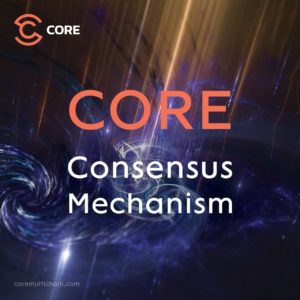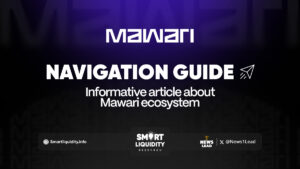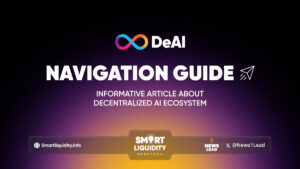Core Navigation Guide
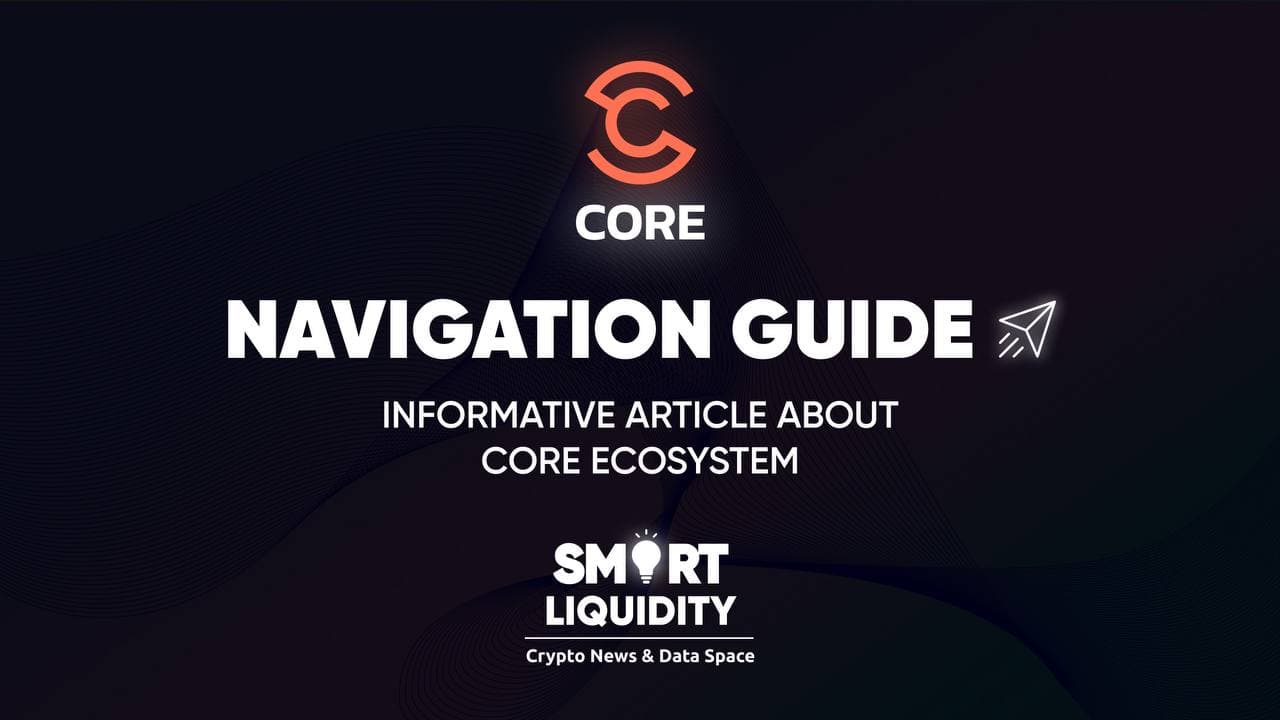

As crypto-enthusiasts, we are very keen on searching for quality projects which we can share to our comrades in the crypto-space. In light of this, we would like to introduce you to the project called “Core”. Together, we will deep dive into its ecosystem and learn how this project becomes beneficial to its users.
What is Core?
CORE is multi-chain PoS Network focused on interoperability, scalability and usability. It utilizes AI Enabled Proof of Stake Algorithm, multi-layered consensus model and voting based governance. CORE Multi-Chain is a next generation blockchain protocol, that enables all legacy, current, and future blockchains to seamlessly scale and communicate with each other. Through sharding, interoperability, and central AI consensus protocol, CORE opens a plethora of possibilities in the blockchain space.
CORE Multi-Chain provides advantages over existing and legacy blockchains such as sharding, simplistic blockchain creation and implementation, cross-chain capabilities, and high transaction throughput.
CORE created a decentralized neighbor selection protocol that continuously strives to
create optimal peer connections to decrease confirmation latency. The protocol achieves
this through continuously analyzing and learning how nodes interact with their neighbor.
How Does Core Protocol Attracts People?
- Lightweight
- Compatible with the self-interests of each peer, or ability to select the best neighbors
- Robust against adversarial actions: A CORE peer does not need all details about a candidate neighbor to decide whether to connect
- Incentivizes peers to relay blocks promptly
- Naturally adaptive to varying hash-power
All types of projects have a unique structure where it can help everyone how to understand a program or technology. A special aspect to make a project even more interesting and attract those who want to use it. Let’s discuss what structure does Core can provide to its users.
Core Network Structure:
- Pivot Chain — it controls the entire network and is responsible for security, consensus, and monitoring
- Poly Chains — its either form instances of an existing blockchain or are independent blockchains with autonomous use cases and tokens.
- Bridges — allow Poly Chains, both private and public, to connect with other public blockchains like Bitcoin and Ethereum without the use of oracles.
Using AI In Core Network
CORE contains an AI model at the core of its blockchain. This AI model helps the network reach consensus effectively and reduces the network’s overall byzantine
fault.
CORE’s AI model coordinates the various roles of each node on the network. To accomplish this, nodes are arranged in a hierarchy based on a trust rating system. The higher the node reaches in the hierarchy, the higher the trust rating. A higher trust rating allows access to vital roles on the network. A node’s trust rating can be negatively impacted and subsequently reduced if the node processes a transaction incorrectly. This mainly includes disrupting or slowing down the network in any way or creating a false transaction.
Uses Of AI In Core Network
The AI randomly selects nodes to test and collate information. This phase identifies corrupt nodes. The selected nodes are listed as inactive during testing. Reactivation occurs once the selected nodes successfully pass all tests or achieve a trust rating above or equal to the threshold set by the network administrators. These tests include:
🕹 Behavioral checks using AI and Machine Learning
🕹 Data integrity checks
🕹 Hardware speed checks
🕹 Network speed checks
Following the testing phase, the node’s results form part of the factors that determine the node’s trust rating. Other factors include reputation on the network and the amount of time active on the network.
Now we will discuss the tokenomics of the Core Network platform. Let’s find out how this ecosystem evolves and what are its use cases. Let us know how it may help its users
The CMCX Token
Native to the CORE platform, the $CMCX token allows users to transact with others on the blockchain, as well as pay for all utility fees in the ecosystem. The token can be used for governance, staking, transactions, smart contracts, and validator rewards on the
platform. CORE is governed by anyone who owns CORE’s native token (CMCX) in a fair and transparent way.
CMCX Tokenomics
- Name: CORE Multi-Chain —Cryptographic Object Resources Engine
- Native Crypto Symbol: CMCX
- Consensus Protocol: Practical Proof of Stake
- Total Supply (Genesis): 20,000,000,000 CMCX
- Pre-mined Reserve: 6,000,000,000 CMCX
- Initial Price: 0.005 USDT
- Current Price: 0.0072 USDT
- Role of Token: Utility
CMCX TOKEN DISTRIBUTION
- Total Supply: 20,000,000,000 CMCX
- Reserve: 6,000,000,000 CMCX (30%)
- Seed Round (Private Founders): 4,000,000,000 CMCX (20%)
- IEO: 4,000,000,000 CMCX (20%)
- Ecosystem Rewards: 2,000,000,000 CMCX (10%)
- Marketing & Operations: 1,000,000,000 CMCX (5%)
- Advisory Board: 600,000,000 CMCX (3%)
- Strategic Acquisitions: 400,000,000 CMCX (2%)
- Team: 2,000,000,000 CMCX (10%)
CORE Consensus Mechanism

A deeper dive into CORE’s enhanced APBFT consensus mechanism exposes two algorithms responsible for the selection of the node that will be the leader and the remaining validator nodes in each of the shards within the network. The primary algorithm used to select the leader and validator nodes in a shard is a randomized function such as VRF. During each new epoch, the VRF function will output the new leader for the shard in an epoch. If the primary randomized function is unable to output a candidate leader and validator node cluster then a secondary algorithm is called within the election process to ensure that the epoch in a specific shard has a dedicated cluster assigned to it.
CORE’s APBFT consensus involves the following steps:
♻️ The leader broadcasts the block header of its formulated block to all the validators.
Simultaneously, the leader broadcasts the content of the block with erasure coding [31],
called the “announce” phase.
♻️ The validators check the validity of the block header. If valid, they sign the block
header with a Boneh-Lynn-Shacham (BLS) signature and send the signature back
to the leader.
♻️ w Once the leader receives 2f H 1 valid signatures from validators, it aggregates them into a BLS multisignature. The leader broadcasts the aggregated multi-signature along with a bitmap indicating which validators have signed. This step combined with step two
make up the “prepare” phase.
♻️ The validators check that the multi-signature has at least 2f H 1 signers, verify the
transactions in the block content broadcasted from the leader in Step one, sign the
received message from Step three and send it back to the leader.
♻️ The leader then waits for at least 2f H 1 valid signatures from step four, aggregates
them together into a BLS multi-signature, and creates a bitmap logging all signers.
Lastly, the leader commits and broadcasts the new block with all multi-signatures and
bitmaps attached for all validators to commit. Step five and four form the “commit”
phase.
To address the scalability issue of PBFT, CORE enhanced the consensus mechanism by reducing the communication complexity within standard PBFT implementations, to create the Accelerated Practical Byzantine Fault Tolerance (APBFT) consensus mechanism.
Consensus Roles
1. VALIDATOR — Nodes on the CORE blockchain, validators process and attest transactions on the blockchain. Through the democratic consensus mechanism, validators are voted on by community members with voting rights. Validators can only be selected if they fit a certain criterion. For example, staking at least the minimum number of tokens required by the network. Community members also must stake tokens to vote on validators.
2. OBSERVER — Observers add to the decentralization and validation of the chain. Observers are either invited by other members in the chain or are members that want to earn rewards in the native token. Participants are not required to stake any coins to become observers and can either be full or light. Full observers actively attest to the formation of blocks and keep a whole history of the chain. Light observers only keep a certain number of epochs of the chain’s history. Both play a vital role in maintaining the integrity of the chain. Rewards are random, similar to a lottery pool. However, an observer’s chances of receiving a rew ard are increased based on how long they have been an observer as well as their work speed and reputation.
3. DEFENDER – A node type that attests to the validity of blocks as they are formed and prior to chain submission, a Defender fishes out any illegal blocks formed by malicious actors on the network and are rewarded for their work. Defenders are either validators on the chain that are not actively involved in consensus or they are observers.
4. NOMINATORS — Members who hold tokens on the chain that nominate staking members as validators for transactions, nominators receive a part of the reward that their nominated validators receive for their work in successfully nominating validators.
5. COLLATORS — Collators each supervise a shard of the main chain. They are responsible for the integrity and validity of their shard and communicate the state of their shard to the main chain.
Core Incentive Model
A distributed system relies on the nodes in the network to maintain security. The nodes are responsible for keeping true records of all transactions that take place within the network and are obliged to act in a way that does not challenge the network’s consensus. As an extra measure to ensure that nodes act correctly, nodes are incentivized by the network to not only maintain security, but to also report any nodes that act maliciously or incorrectly in a manner that risks the security of the network.
In Proof of Stake, validators are rewarded for validating and attesting to blocks with
correct transactions. The distribution of the rewards for the validation of a block depends on the number of votes a node gave the block. The distribution of the mining transactions within the block are distributed likewise. If a node validates or attests to a block of false transactions then its stake is slashed. If a node reports a dishonest node to the network, it receives rewards in the cryptocurrency that was slashed from the dishonest node’s stake. This incentivizes nodes to act within the rules of the network’s consensus and report dishonest nodes.
The CORE ecosystem uses the same incentive system within all nodes to ensure the security of the blockchain. CORE’s incentive model combined with the AI-based consensus protocol creates an extremely secure blockchain ecosystem.
Core Pivot Chain And Poly Chain
The main CORE Blockchain is composed of several shards categorized in two ways: Pivot Chains and Poly Chains.
Pivot Chain, the foundation of the CORE platform, controls and coordinates the whole
network and is responsible for security, consensus, and monitoring. The validators in the CORE Blockchain stake the native cryptocurrency in the Pivot Chain. Since the main
responsibility of the Pivot Chain is to coordinate the network, it has minimal functionality to ensure that it fulfills its responsibilities.
One of the Pivot Chain’s main responsibilities is to maintain the security of the network. It helps strengthen the security and consistency of the various states of the shards that
make up the network by including the block header from each shard chain. After a new
block has been committed to a shard chain its block header is sent to the Pivot Chain.
The Pivot Chain then checks the validity of the block header by:
- Verifying the hash of the previous block already committed in the Pivot Chain.
- Verifying the signers of the block’s multi-signature to ensure validator correctness for that shard.
The committed block headers at the Pivot Chain are then broadcasted to the network.
After the broadcast, each shard appends the block headers to its own internal chain that
tracks valid block headers of all other shards in the network. These internal chains verify
the validity of transactions from other shards.
Adding the shard chains’ block headers into the Pivot Chain provides the following benefits:
- The difficulty of attacking a single shard is increased as attackers must corrupt both the shard chain and Pivot Chain to convince other shards that an alternative block is valid.
- Reduced network cost associated with broadcasting the block headers among shards.
Other specific work is delegated to the Poly Chains, which have differing implementations and features. Poly Chains, multiple chains that run simultaneously, can either be an instance of an existing blockchain or independent blockchains with their own use cases and tokens. A Poly Chain is a blockchain that processes and validates its own transactions as well as stores its own state.
Core Multi-Layered Blockchain Framework
1. ORIGO Source & Origin, the first layer of the Core blockchain is the network layer. This layer is the brain of the system. Its the orchestration and communication in the formation of blocks on the blockchain. This layer usually males use of the web for decentralized communication between the blockchain. 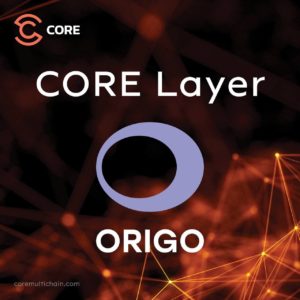

2. CATENA CHAIN, the second layer is the blockchain layer. This layer is where the actual block for formation takes place and where the blockchain is appended with the newly formed blocks. It is built on top of the networking layer.
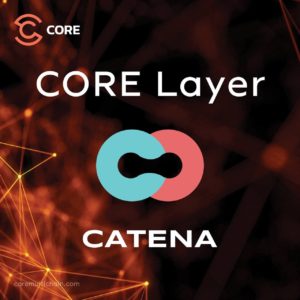

3. AURA a distinctive atmosphere surrounding a given source. The third layer is the application layer. This layer is built on top of the network and blockchain layers and is where blockchain use cases are develop. This is the layer where users interact with.
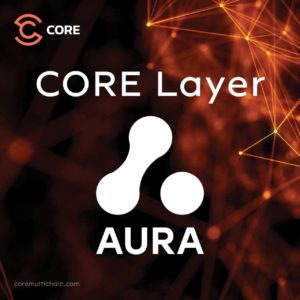

Blockchain scaling solutions are divided into different layers, mainly layer 1 and layer 2. Layer 1 scaling refers to altering the blockchain itself to increase scalability. Altering the blockchain directly is complicated.
Layer 2 scaling refers to increasing a blockchain’s throughput by innovating off the
physical blockchain and enabling off-chain transaction processing. Authenticated
messages sent between users transacting off-chain accomplishes this. These authenticated messages pass through a medium external to the first layer, the physical blockchain, but are still linked to it. The main blockchain is only called to resolve disputes. Its consensus algorithm determines the security and non-custodial properties of the second layer.
Core Upgrade
Forkless upgrading is a future-proof concept that enables the upgradability of a
blockchain without having to fork it. Inspired by Substrate framework, CORE blockchain includes a forkless upgrading feature made possible by CORE’s on-chain
governance system, allowing for agile blockchain development and improvement. The CORE network includes its own virtual machine inspired by the EVM. Using the EVM as a blueprint, CORE has created a virtual machine that transcends the limitations present
in the EVM to enable the scalable and sustainable development of decentralized applications.
Core Apeirogon Framework
CORE’s Apeirogon framework simplifies blockchain creation allowing developers to focus on optimizing their blockchain for specific use cases. Modular by nature, the
framework enables the user to implement ready-made, fully customizable components
or modules like networking and consensus to fit user needs. Apeirogon comes with a wide range of tools that streamline the blockchain development process and allows the simple implementation of custom business logic. Developers can effortlessly combine
ready-made components offered by the Apeirogon framework with their custom developed components to create the enterprise-level blockchain desired.
Apart from the ready-made components and modules available on the Apeirogon
framework, developers can utilize a range of development engines that open up additional customization and functionality such as choice of consensus algorithm or a custom cryptographic hash function. Developers can make use of Apeirogon’s State, Tokenizer, Consensus, and Cryptography Engines.
Apeirogon’s ecosystem uses a state-of-the-art, peer-to-peer network platform called
libp2p, a modular system of protocols, specifications, and libraries for developing
peer-to-peer network applications. Integrating with blockchains both internal and external to the CORE ecosystem is also possible with Apeirogon’s native blockchain connection capabilities such as cross-chain communication, collaboration, and shared security.
Cross-blockchain data transmission can be securely isolated by using a TPPL and P2P
communication and routing inspired by the Invisible Internet Project (I2P). A universal
layer applied to every CORE-connected chain, TPPL adds an extra layer of security and
privacy when transacting on a blockchain. Developed using Rust, Haskell, C++, and Golang, CORE and Apeirogon obtain optimum execution and safety. The most advanced in the market, these programming languages provide high speeds and robust performance. WebAssembly (Wasm), a super performant virtual environment that allows running code written in multiple languages on the web at near-native speed, provides the platform for Apeirogon’s runtime architecture.
This combination makes the Apeirogon framework a robust, optimized, and efficient solution for custom blockchain development needs.
CORE Testnet
Déjà Vu Testnet — is the experimental playground blockchain for CORE. Developers can test their blockchain applications and integrate with all the available services that CORE offers without interrupting the Mainnet’s operations. Additionally, it includes a faucet and a block explorer, so developers can undergo unlimited testing of their applications and easily track transactions within their application during the testing phase.
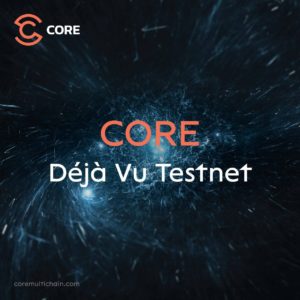

CORE’s community members who stake the network’s native cryptocurrency maintain and govern the Déjà Vu Testnet. It also functions as an independent blockchain. Developers integrating with the testnet can explore CORE technology limits in real-world applications before deploying to the CORE Mainnet.
CORE OTHER FEATURES
CORE Bridge — CORE bridges allow resources, data, and information to be shared between multiple blockchains in different ecosystems, which is a limitation currently present in blockchain technology. This cross-chain communication is called interoperability. CORE utilizes sophisticated technology into one streamlined, efficient, and high speed cross-chain communication protocol.
CORE Universal Block Explorer — CORE has a universal block Explorer that allows anyone to view blocks on any CORE-connected chain as well as all of the major public chains such as Bitcoin, Ethereum, etc. CORE grants anyone a simple solution to search a multitude of blockchains.
Transaction Privacy Protection Layer — CORE transaction privacy protection layer (TPPL) adds an extra layer of security and privacy when transacting on its blockchain. This is a universal layer that is applied to every CORE-connected chain and can be applied to the major public blockchains.
Seamless Access to Off-Chain Data — Oracles are an exciting innovation in the decentralized application space. They are a streamlined data sharing solution between the decentralized and physical world. CORE provides an efficient and simple access point for developers to retrieve off-chain data, similar to Oracles. CORE’s data solution enables decentralized-apps and smart contracts on the CORE chain to use data from other CORE-linked chains and the the major blockchains.
Universal blockchain Access API for Developers — CORE’s universal API is a cross-chain, enterprise-ready, development solution that allows developers to easily develop blockchain apps on both CORE-linked blockchains and the major blockchains.
CORE is able to increase the throughput speed of current blockchain technology linearly through a combination of sharding, pipelining, and its multilayer technology into one cross-shard and cross-chain communication protocol. The protocol is able to take the large number of transactions from a large ecosystem and split them into smaller ecosystems. These smaller ecosystems are then able to process the transactions in parallel to each other and simultaneously communicate live updates to the other ecosystems. These ecosystems are directly correlated to the size of CORE’s community. So, as the community grows the ecosystems will grow, resulting in faster throughput of larger volumes.
Upon writing, Core platform is having a live $CMCX presale via an initial exchange offering on IndoEx International and ProBit Exchange launchpads. Don’t miss a chance to be the first adopter of Core ecosystem, be a contributor for this spectacular project now is rapidly growing.
RESOURCES
Website | Twitter | Telegram | LinkedIn | GitHub
FRIENDLY REMINDER
“We deliver the news article base on our own thorough research. We want to preserved some important information regarding with the project that are presented in our column. We value our reader’s opinion and we thank you for your valued respect to us.We also don’t advice our readers to invest. As we always say ” Invest at your own risk and only invest what you can afford to lose “.
